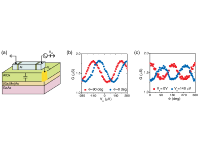Researchers from the Institute of Physics ASCR contributed to a review of a prominent field of modern physics
Over the past two decades, the research of ferromagnetic semiconductors, with (Ga,Mn)As as a prime example, has led to a deeper understanding of relativistic spin-dependent phenomena in magnetic systems. It has also led to discoveries of new effects and demonstrations of unprecedented functionalities in experimental micro-electronic and opto-electronic devices.
Researchers from the Institute of Physics of the Academy of Sciences in Prague, in collaboration
with researchers from the Charles University in Prague and from the UK, have published a
comprehensive review of this active field of condensed matter physics in the journal Reviews of
Modern Physics (
abstract
).
Ferromagnetic semiconductors represent a favourable class of materials integrating the
charge-based and spin-based functionalities of micro-electronic and opto-electronic devices.
Semiconductor silicon microprocessors are prime examples among the large variety of charge-based
devices. They utilize the possibility offered by semiconductors to easily electrically manipulate
and detect their electronic charge states representing the zeros and ones. Spin-based devices
operate on an entirely distinct principle. In some materials, like iron, electron spins
spontaneously align their direction, what subsequently generates magnetism of such material. The
position of the north and south pole of the magnet can be used to represent the zeros and ones.
This technology is behind memory applications such as computer hard disks.
Ferromagnetic-semiconductors can simultaneously behave like silicon and iron which offers the
unique possibility to investigate the charge and spin functionalities in one material.
The leading position of the Czech team in the international research of ferromagnetic
semiconductors, acknowledged by the invitation to prepare the comprehensive Reviews of Modern
Physics article, is an outgrowth of the decade’s materials development and device nano-fabrication
activities, magnetic, electrical, and optical experiments, and an extensive theoretical
modeling.

For detail information contact Tomas Jungwirth from the Institute of Physics AVCR, v.v.i.,
Cukrovarnická 10, 162 53 Praha 6, e-mail:
jungw@fzu.cz
31 Oct 2014







Her parents are employed in the IMG (project BIOCEV). Because Katareeya originates from a “third country”, namely, Australia, according to the Czech legislation she is not entitled to healthcare support from the public healthcare insurance.
The cost of intensive therapy during first two months have already exceeded the limits of private insurance in the amount of 1,6 million CZK. All the cost now repose only on the girl’s parents.
More information...